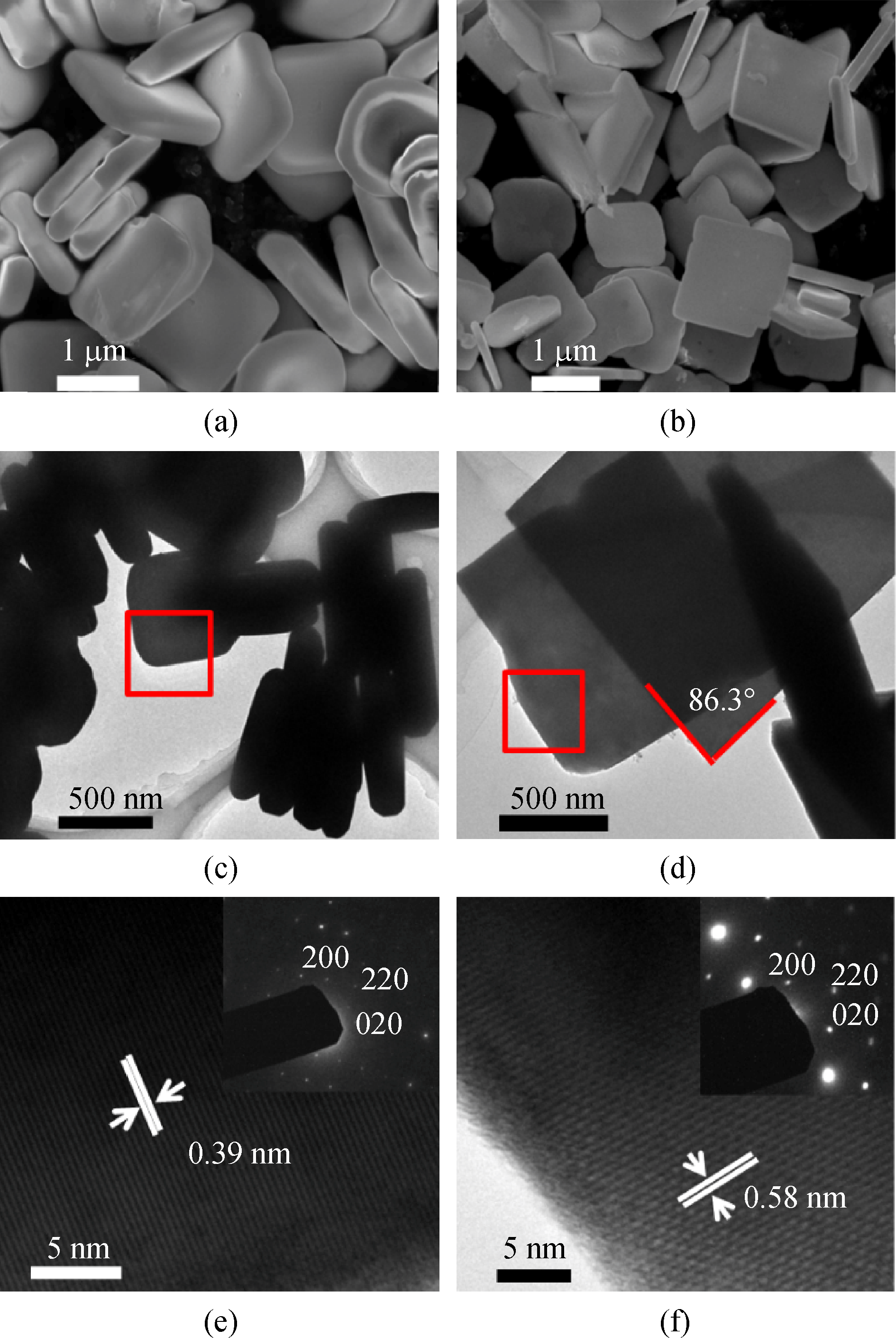 PDF(1506 KB)
PDF(1506 KB)


Spontaneous polarization enhanced bismuth ferrate photoelectrode: fabrication and boosted photoelectrochemical water splitting property
 PDF(1506 KB)
PDF(1506 KB)
 PDF(1506 KB)
PDF(1506 KB)
Spontaneous polarization enhanced bismuth ferrate photoelectrode: fabrication and boosted photoelectrochemical water splitting property
In this paper, the fabrication of a highly orientated Bi2Fe4O9 (BFO) photoelectrode in the presence of two-dimensional (2D) graphene oxide (GO) was reported. It was found that the GO can be used as a template for controlling the growth of BFO, and the nanoplate composites of BFO/reduced graphene oxide (RGO) with a high orientation can be fabricated. The thickness of the nanoplates became thinner as the ratio of GO increased. As a result, the ferroelectric spontaneous polarization unit arranges itself in the space in a periodic manner, leading to the formation of a polarization field along a special direction. Therefore, the created built-in electric field of the nanoplate composites of BFO/RGO is improved upon the increase of the amount of RGO. As expected, carrier separation is enhanced by the built-in electric field, therefore substantially enhancing the photoelectrochemical (PEC) activity of water splitting compared to pure BFO under the irradiation of visible-light.

bismuth ferrate / ferroelectric polarisation / photoelectrochemical (PEC) water splitting / graphene oxide (GO) / high orientation
| [1] |
Fujishima A, Honda K. Electrochemical photolysis of water at a semiconductor electrode. Nature, 1972, 238(5358): 37–38
CrossRef
ADS
Google scholar
|
| [2] |
Wang Y, Liu X, Wang X,
CrossRef
ADS
Google scholar
|
| [3] |
Chen X, Jin F. Photocatalytic reduction of carbon dioxide by titanium oxide-based semiconductors to produce fuels. Frontiers in Energy, 2019, 13(2): 207–220
CrossRef
ADS
Google scholar
|
| [4] |
Chen Y, Wang L, Wang W,
CrossRef
ADS
Google scholar
|
| [5] |
Ding D, Liu K, He S,
CrossRef
ADS
Google scholar
|
| [6] |
Ha J W, Ruberu T P A, Han R,
CrossRef
ADS
Google scholar
|
| [7] |
Xiao F, Miao J, Tao H,
CrossRef
ADS
Google scholar
|
| [8] |
Fang W, Zhou J, Liu J,
CrossRef
ADS
Google scholar
|
| [9] |
Yang Z, Wan Y, Xiong G,
CrossRef
ADS
Google scholar
|
| [10] |
Maletin M, Moshopoulou E G, Kontos A G,
CrossRef
ADS
Google scholar
|
| [11] |
Yang B, Yuan Y, Sharma P,
CrossRef
ADS
Google scholar
|
| [12] |
Cui W, Xia Z, Wu S,
CrossRef
ADS
Google scholar
|
| [13] |
Paracchino A, Laporte V, Sivula K,
CrossRef
ADS
Google scholar
|
| [14] |
Paracchino A, Mathews N, Hisatomi T,
CrossRef
ADS
Google scholar
|
| [15] |
Ling Y, Wang G, Reddy J,
CrossRef
ADS
Google scholar
|
| [16] |
Franking R, Li L, Lukowski M A, Meng F,
CrossRef
ADS
Google scholar
|
| [17] |
Klahr B, Gimenez S, Fabregat-Santiago F,
CrossRef
ADS
Google scholar
|
| [18] |
Shen R, Ren D, Ding Y,
CrossRef
ADS
Google scholar
|
| [19] |
Liang Z, Shen R, Ng Y H,
CrossRef
ADS
Google scholar
|
| [20] |
Luo W, Yang Z, Li Z,
CrossRef
ADS
Google scholar
|
| [21] |
McDonald K J, Choi K S. A new electrochemical synthesis route for a BiOI electrode and its conversion to a highly efficient porous BiVO4 photoanode for solar water oxidation. Energy & Environmental Science, 2012, 5(9): 8553
CrossRef
ADS
Google scholar
|
| [22] |
Luo W, Wang J, Zhao X,
CrossRef
ADS
Google scholar
|
| [23] |
Chen Z, Zhang N, Xu Y. Synthesis of graphene-ZnO nanorod nanocomposites with improved photoactivity and anti-photocorrosion. CrystEngComm, 2013, 15(15): 3022–3030
CrossRef
ADS
Google scholar
|
| [24] |
Gao F, Chen X, Yin K,
CrossRef
ADS
Google scholar
|
| [25] |
Papadas I T, Subrahmanyam K S, Kanatzidis M G,
CrossRef
ADS
Google scholar
|
| [26] |
Ruan Q, Zhang W. Tunable morphology of Bi2Fe4O9 crystals for photocatalytic oxidation. Journal of Physical Chemistry C, 2009, 113(10): 4168–4173
CrossRef
ADS
Google scholar
|
| [27] |
Hu Z, Chen B, Lim T T. Single-crystalline Bi2Fe4O9 synthesized by low-temperature co-precipitation: performance as photo- and Fenton catalysts. RSC Advances, 2014, 4(53): 27820–27829
CrossRef
ADS
Google scholar
|
| [28] |
Li Y, Zhang Y, Ye W,
CrossRef
ADS
Google scholar
|
| [29] |
Poghossian A S, Abovian H V, Avakian P B,
CrossRef
ADS
Google scholar
|
| [30] |
Zhang X, Bourgeois L, Yao J,
CrossRef
ADS
Google scholar
|
| [31] |
Zhang X, Lv J, Bourgeois L,
CrossRef
ADS
Google scholar
|
| [32] |
Liu M, Lin C, Gu Y,
CrossRef
ADS
Google scholar
|
| [33] |
Geim A K. Graphene: status and prospects. Science, 2009, 324(5934): 1530–1534
CrossRef
ADS
Google scholar
|
| [34] |
Li X, Yu J, Wageh S,
CrossRef
ADS
Google scholar
|
| [35] |
Li X, Shen R, Ma S,
CrossRef
ADS
Google scholar
|
| [36] |
Wu Y, Luo H, Jiang X,
CrossRef
ADS
Google scholar
|
| [37] |
Zhang Y, Zhu Y, Yu J,
CrossRef
ADS
Google scholar
|
| [38] |
Zhou F, Shi R, Zhu Y. Significant enhancement of the visible photocatalytic degradation performances of γ-Bi2MoO6 nanoplate by graphene hybridization. Journal of Molecular Catalysis A Chemical, 2011, 340(1–2): 77–82
CrossRef
ADS
Google scholar
|
| [39] |
Li X, Yu J, Jaroniec M,
CrossRef
ADS
Google scholar
|
| [40] |
Park H S, Kweon K E, Ye H,
CrossRef
ADS
Google scholar
|
/
| 〈 |
|
〉 |